Introduction
Science is a fascinating field that encompasses a wide range of subjects, from the tiniest particles to the vastness of the universe. It can sometimes seem complex and intimidating, but with the right approach, anyone can embark on a journey through the wonders of science. This article aims to provide a fun and easy introduction to the world of science, using simple English and engaging examples to make learning about scientific concepts enjoyable and accessible.
The Building Blocks of Science
1. What is Science?
Science is the systematic study of the natural world and the search for knowledge about how things work. It is based on observation, experimentation, and evidence.
Example: Imagine you are curious about why leaves change color in autumn. You could start by observing the leaves and taking notes. Then, you might conduct experiments to see how different conditions affect leaf color.
2. The Scientific Method
The scientific method is a process used by scientists to investigate questions and solve problems. It involves making observations, forming a hypothesis, conducting experiments, and analyzing the results.
Example: Suppose you want to find out if plants grow better with or without sunlight. You would set up two pots of plants, one in direct sunlight and the other in a dark room. After a certain period, you would compare the growth of the plants to determine the effect of sunlight.
Exploring Different Scientific Fields
3. Physics
Physics is the study of matter, energy, and the fundamental forces that govern the universe.
Example: Learn about gravity by dropping a ball and observing how it falls to the ground. You can also explore the concept of inertia by pushing a toy car on a smooth surface and noticing how it continues to move even after you stop pushing it.
4. Chemistry
Chemistry is the study of substances, their properties, and the changes they undergo.
Example: Experiment with mixing baking soda and vinegar to create a chemical reaction that produces carbon dioxide gas, which you can observe as bubbles.
5. Biology
Biology is the study of living organisms and their interactions with the environment.
Example: Observe the life cycle of a caterpillar by keeping one in a jar and watching it transform into a butterfly.
6. Earth Science
Earth science is the study of the Earth, including its physical structure, composition, and history.
Example: Investigate the layers of the Earth by making a model of a geode, a rock with a hollow center filled with crystals.
Making Science Fun
7. Science Experiments
One of the best ways to learn about science is through hands-on experiments. Here are a few simple experiments you can try at home:
Vanishing Color:
- Materials: Red cabbage, vinegar, water, clear glass cups.
- Instructions: Boil red cabbage in water and strain the liquid into cups. Add different substances to each cup (e.g., water, milk, lemon juice) and observe the color changes.
Magnetism:
- Materials: Magnets, iron filings, paper.
- Instructions: Place a magnet under a piece of paper and sprinkle iron filings over the paper. Observe how the filings line up with the magnetic field.
Leaves and Water:
- Materials: Leaves, water, clear plastic bag, tape.
- Instructions: Place a leaf in a clear plastic bag, add water, and seal it. Observe how the leaf stays hydrated for several days.
8. Science Games and Apps
There are many fun science games and apps available that can make learning about science interactive and engaging. Some popular options include:
- Mystery Science
- Labster
- Google Science Journal
Conclusion
Unlocking the world of science can be an exciting and rewarding journey. By using simple English and engaging examples, anyone can explore the wonders of the natural world and develop a deeper understanding of how it works. So, grab some curiosity, open your mind, and let’s embark on a fun and easy English科普 journey together!
